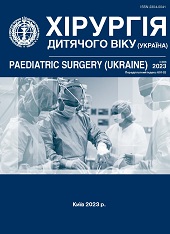The first intravital case of diagnosis and treatment of a giant teratoma of the sacrococcygeal area, which exceeded the body weight of a newborn on 1.5 times
DOI:
https://doi.org/10.15574/PS.2023.80.92Keywords:
giant sacrococcygeal teratoma, perinatal diagnosis, fetus, newborn child, hypoxic-ischemic damage of internal organsAbstract
Purpose - is to analyze and present the experience of perinatal diagnosis and treatment of giant terato-dermoid tumor (TDT) of the sacrococcygeal area, which exceeded the body weight of a newborn on 1.5 times.
Clinical case. The article presents a unique clinical case of a giant teratoma of the sacrococcygeal area (SCT), which exceeded the weight of a newborn child on 1.5 times. Features of perinatal support, hypoxic-ischemic damage of internal organs, and surgical intervention for giant SCT in a premature low-weight newborn child are described, which are important elements of optimizing the treatment of children with this life-threatening pathology.
Conclusions. Diagnosis and treatment of giant SCT in fetuses and newborns require scientifically based perinatal support, which includes early (up to 22 weeks of gestation) prenatal diagnosis, rational pregnancy management tactics, fetal examination, delivery by caesarean section, postnatal diagnosis and early (within 1 days) emergency radical tumor removal.
The research was carried out in accordance with the principles of the Helsinki Declaration. The informed consent of the patient was obtained for conducting studies.
No conflict of interests was declared by the authors.
References
Hambraeus M, Arnbjörnsson E, Börjesson A, Salvesen K, Hagander L. (2016, Mar). Sacrococcygeal teratoma: A population-based study of incidence and prenatal prognostic factors. J Pediatr Surg. 51 (3): 481-485. https://doi.org/10.1016/j.jpedsurg.2015.09.007; PMid:26454470
Pauniaho SL, Heikinheimo O, Vettenranta K et al. (2013). High prevalence of sacrococcygeal teratoma in Finland - a nationwide population-based study. Acta Paediatr. 102: e251-256. https://doi.org/10.1111/apa.12211; PMid:23432104
Girwalkar-Bagle A, Thatte W, Gulia P. (2014). Sacrococcygeal teratoma: a case report and review of literature. Anaesth Pain Intensive Care. 18 (4): 449-451.
Patil P, Kothari P, Gupta A et al. (2016). Retroperitoneal mature custic teratoma in a neonate: a case report. J Neonatal Surg. 5 (2): 15. https://doi.org/10.47338/jns.v5.282; PMid:27123399 PMCid:PMC4841371
Mondal M, Biswas B, Roy A et al. (2014). A neglected case of Sacrococcygeal teratoma in a neonate. Asian J Med Sci. 6 (2): 108-110. https://doi.org/10.3126/ajms.v6i2.10448
Altman RP, Randolph JG, Lilly JR. (1974). Sacrococcygeal teratoma: American Academy of Pediatrics Survey. J Pediatr Surg. 9 (3): 389-398. https://doi.org/10.1016/S0022-3468(74)80297-6; PMid:4843993
Mohta A, Khurana N. (2011). Fetus-In-Fetu or Well-Differentiated Teratoma - A Continued Controversy. Indian J Surg. 73: 372-374. https://doi.org/10.1007/s12262-011-0251-4; PMid:23024547 PMCid:PMC3208714
Coleman A, Kline-Fath B, Keswani S et al. (2013). Prenatal solid tumor volume index: novel prenatal predictor of adverse outcome in sacrococcygeal teratoma. J Surg Res. 184: 330-336. https://doi.org/10.1016/j.jss.2013.05.029; PMid:23773720
Makin EC, Hyett J, Ade-Ajayi N et al. (2006). Outcome of antenatally diagnosed sacrococcygeal teratomas: single-center experience (1993-2004). J Pediatr Surg. 41 (2): 388-393. https://doi.org/10.1016/j.jpedsurg.2005.11.017; PMid:16481257
Yamaguchi Y, Tsukimori K, Hojo S, Nakanami N, Nozaki M, Masumoto K et al. (2006, Oct). Spontaneous rupture of sacrococcygeal teratoma associated with acute fetal anemia. Ultrasound Obstet Gynecol. 28 (5): 720-722. https://doi.org/10.1002/uog.3821; PMid:16958151
Lawrence KM, Hennessy-Strahs S, McGovern PE, Mejaddam AY, Rossidis AC, Baumgarten HD et al. (2018, Dec 20). Fetal hypoxemia causes abnormal myocardial development in a preterm ex utero fetal ovine model. JCI Insight. 3 (24). https://doi.org/10.1172/jci.insight.124338; PMid:30568044 PMCid:PMC6338387
Gucciardo L, Uyttebroek A, De Wever I, Renard M, Claus F, Devlieger R et al. (2011, Jul). Prenatal assessment and management of sacrococcygeal teratoma. Prenat Diagn. 31 (7): 678-688. https://doi.org/10.1002/pd.2781; PMid:21656530
Lee EY. (1965, Dec). Foetus in foetu. Arch Dis Child. 40 (214): 689-693. https://doi.org/10.1136/adc.40.214.689; PMid:5891759 PMCid:PMC2019482
Wakhlu A, Misra S, Tandon RK, Wakhlu AK. (2002, Sep). Sacrococcygeal teratoma. Pediatr Surg Int. 18 (5-6): 384-387. https://doi.org/10.1007/s00383-002-0729-z; PMid:12415361
Gupta BD, Sharma P, Bagla J, Parakh M, Soni JP. (2005, Sep). Renal failure in asphyxiated neonates. Indian Pediatr. 42 (9): 928-934.
Gharpure V. (2013, Apr 1). Sacrococcygeal teratoma. J Neonatal Surg: 28. https://doi.org/10.47338/jns.v2.40; PMid:26023448 PMCid:PMC4420369
Zaghloul N, Ahmed M. (2017, Nov). Pathophysiology of periventricular leukomalacia: What we learned from animal models. Neural Regen Res. 12 (11): 1795-1796. https://doi.org/10.4103/1673-5374.219034; PMid:29239318 PMCid:PMC5745826
Phi JH. (2021, May). Sacrococcygeal Teratoma: A Tumor at the Center of Embryogenesis. J Korean Neurosurg Soc. 64 (3): 406-413. https://doi.org/10.3340/jkns.2021.0015; PMid:33906346 PMCid:PMC8128526
Zvizdic Z et al. (2023, Mar). A Long-Term Outcome of the Patients with Sacrococcygeal Teratoma: A Bosnian Cohort. Turk Arch Pediatr. 58 (2): 168-173. https://doi.org/10.5152/TurkArchPediatr.2023.22268; PMid:36856354 PMCid:PMC10081131
Downloads
Published
Issue
Section
License
Copyright (c) 2023 Paediatric Surgery (Ukraine)

This work is licensed under a Creative Commons Attribution-NonCommercial 4.0 International License.
The policy of the Journal “PAEDIATRIC SURGERY. UKRAINE” is compatible with the vast majority of funders' of open access and self-archiving policies. The journal provides immediate open access route being convinced that everyone – not only scientists - can benefit from research results, and publishes articles exclusively under open access distribution, with a Creative Commons Attribution-Noncommercial 4.0 international license(СС BY-NC).
Authors transfer the copyright to the Journal “PAEDIATRIC SURGERY.UKRAINE” when the manuscript is accepted for publication. Authors declare that this manuscript has not been published nor is under simultaneous consideration for publication elsewhere. After publication, the articles become freely available on-line to the public.
Readers have the right to use, distribute, and reproduce articles in any medium, provided the articles and the journal are properly cited.
The use of published materials for commercial purposes is strongly prohibited.

